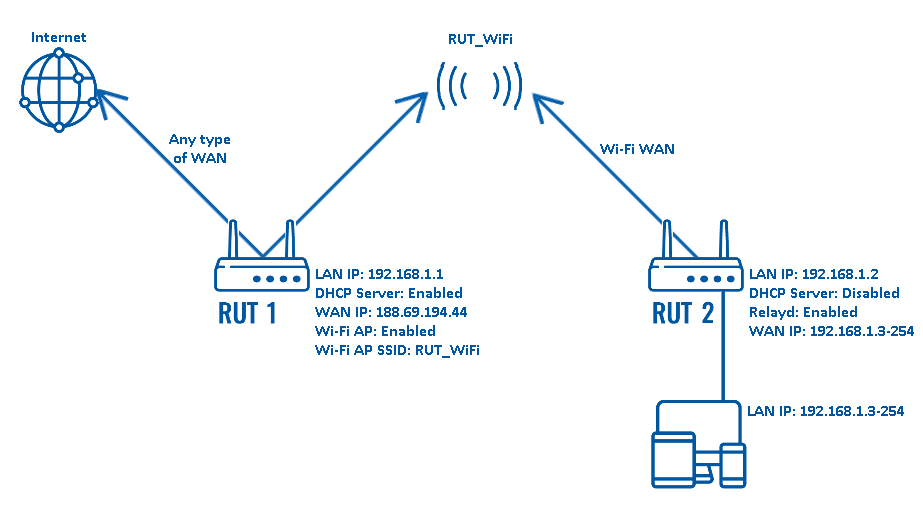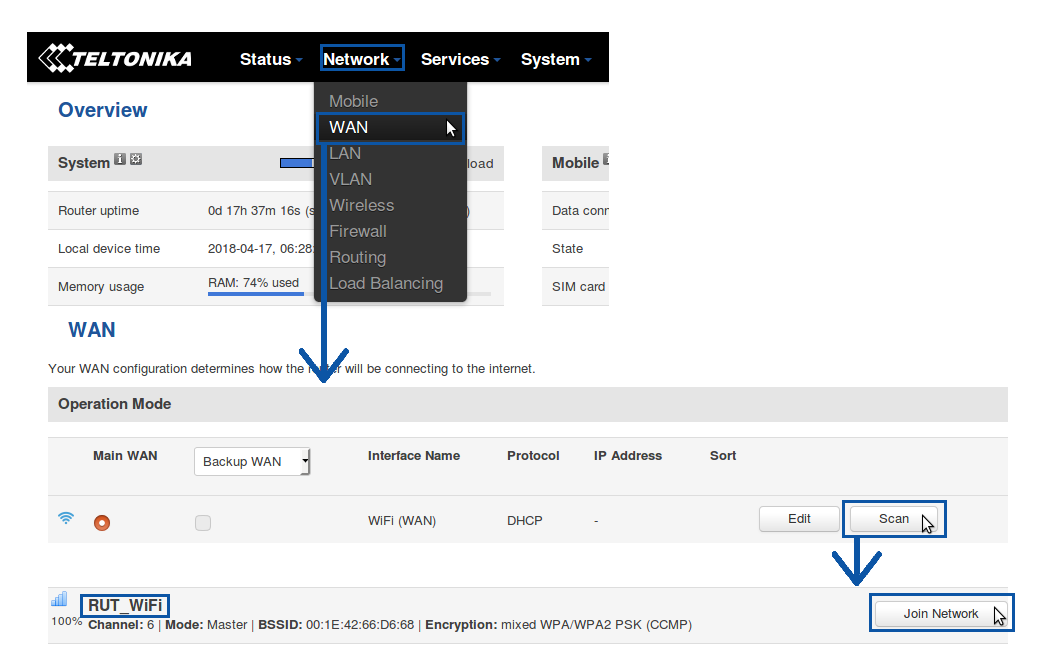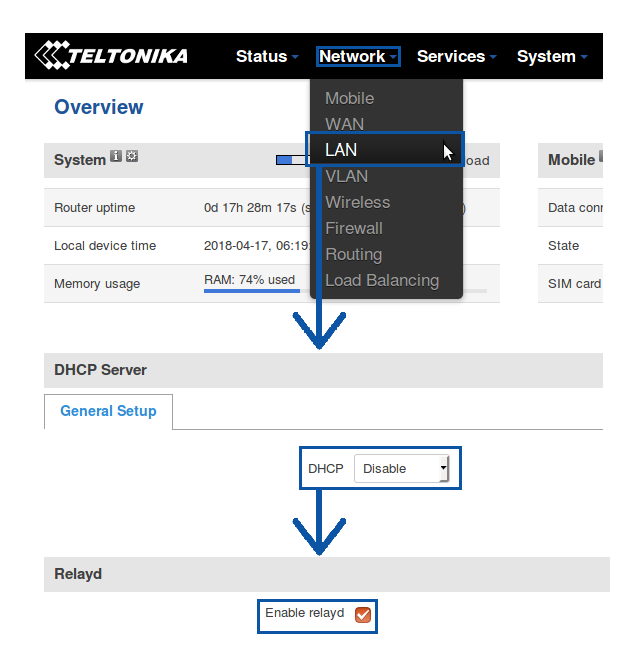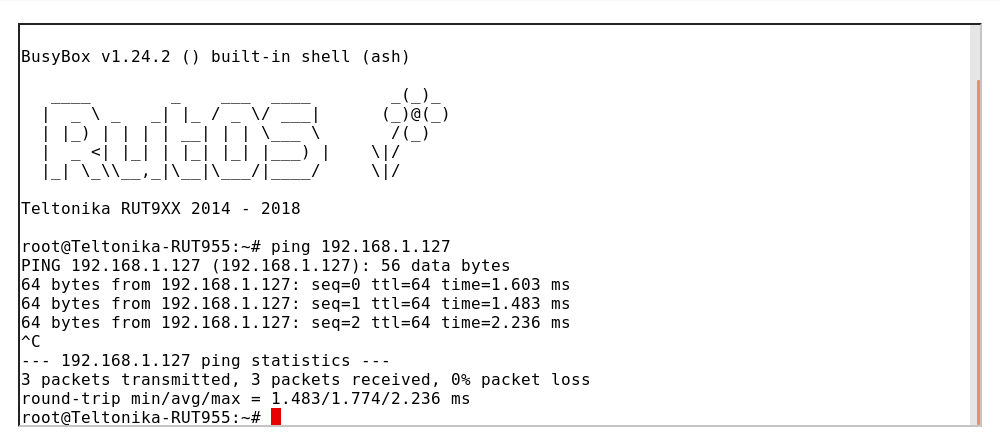Relayd
Introduction
Relayd is a daemon to relay and dynamically redirect incoming connections to a target host. Its main purpose in RUT routers is extending the wireless network. For example, when RUT is in STA (Wireless Station) mode, it can be used to bridge WAN and LAN interfaces to create a larger Wireless network.
This article provides an extensive configuration example of a basic Relayd usage scenario with RUT devices.
Configuration overview and prerequisites
Before we begin, let's overview the configuration that we are attempting to achieve and the prerequisites that make it possible.
Prerequisites:
- Two RUT routers (one of them with active data connection)
- An end device(s) (PC, Laptop, Tablet, Smartphone)
Configuration scheme:
The scheme depicts two RUT routers - RUT1 and RUT2. RUT1 has access to the Internet through an undefined type of WAN (it can be any). RUT2 acts as a Wi-Fi Station (STA) and gains access to the Internet via RUT1's Wi-Fi Access Point (AP) (SSID: RUT_WiFi). RUT2's DHCP Server is disabled. This is done so that the end devices connected to RUT2 get IP addresses from RUT1's DHCP Server with the help of Relayd.
So in short, this type of configuration connects devices from different networks into a single network, making it possible for the devices to communicate with each other and providing the devices with an Internet connection.
NOTE: the parameters displayed in the scheme above will be used in further examples of this guide. Parameters like LAN IP addresses and Wi-Fi SSID should be chosen in accordance with your own needs.
Router configuration
If you have familiarized yourself with the configuration scheme and have all of the devices in order, you can start configuring your routers using instructions provided in this section.
RUT1
The configuration for RUT1 is fairly simple. You only need to make sure that the router has:
- An active data connection (WAN type doesn't matter; use what is available to you or what best suits your needs)
- An active Wi-Fi Access Point (AP)
- An active DHCP Server
A Wi-Fi Access Point (AP) and DHCP Server are enabled by default on RUT routers, but if you wish to make changes, you can find the configuration pages of these services by logging in to the router's WebUI and visiting the Network → Wireless section for Wi-Fi and Network → LAN for DHCP. For additional information on these pages, visit their respective Manual chapters:
RUT2
The key things you need to configure in RUT2 are:
- Enable Wi-Fi WAN and connect to RUT1's Wi-Fi Access Point
- Enable Relayd and disable DHCP Server
These steps should be taken in the order they are presented in, because if you disable RUT2's DHCP Server first, you may lose access to your router. So let's begin by setting up Wi-Fi WAN.
Wi-Fi WAN
To set up Wi-Fi WAN, log in to the router's WebUI and navigate to the WAN section found under the Network tab. Choose WiFi as your Main WAN option and click the Save button. After this, a Scan button should appear. Click it and it will initiate a scan for nearby Wi-Fi Access Points. Choose RUT1's Access Point and click Join network:
You can visit the Wireless Station chapter for additional information on Wi-Fi WAN.
Relayd and DHCP Server
Configuration for both DHCP and Relayd takes in the LAN section of the router's WebUI. Simply log in, navigate to the LAN section which is located under the Network. In the LAN page set DHCP to Disable, check the Enabled relayd field and click Save:
Testing the set up
If you've taken all of the steps described above, the configuration is done. But as with any other configuration, it is always wise to test the set up in order to make sure that it works properly. To test this set up, log in to any of the routers go to Services → CLI. Log in with user name: root and the router's admin password. You should then be able to ping the other router or any of the end devices that you have connected to either of the two router's. To execute a ping command, type ping <devices_ip> into the console and press the Enter key:
Replace <devices_ip> with an actual IP address of a device that is in your network and if the ping requests are successful it means the configuration is working. You can check the IP addresses of the devices connected to your network in RUT1's Status → Network → LAN section.
Additional notes
An important issue to bring up is that the two routers will not be able to communicate with each other via their LAN IPs if they have LAN IP addresses in different subnets. If that is the case, there are still a few options you can take without changing either of the routers IP addresses:
- When communicating between routers, use RUT2's WAN IP instead of its LAN IP. This will work because RUT1 will lease the WAN IP address to RUT2 from its LAN network. If that is the case you chose, then don't forget to check RUT2's WAN IP after completing the 3.2.1 step of this guide
- Add Static Routes to each router in the Network → Routing → Static Routes section. This must be done from both ends, i.e., you must configure a route both in RUT1 and in RUT2
The communication between RUT1 and the end devices in either network will work regardless of what RUT2's LAN IP address is.




